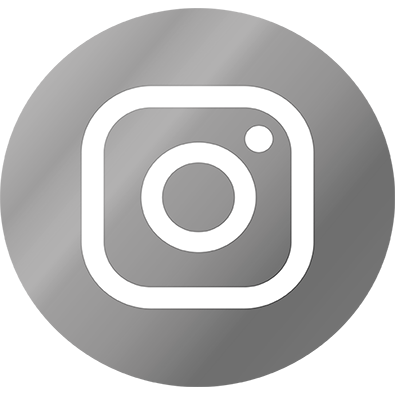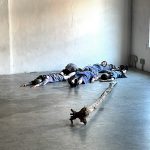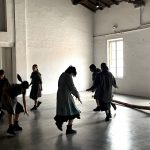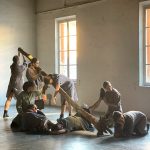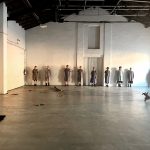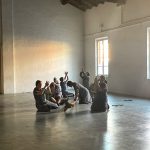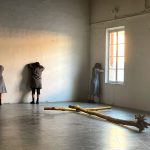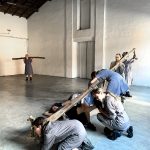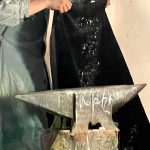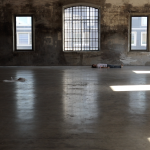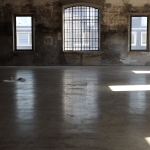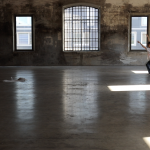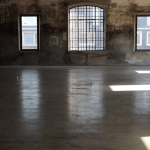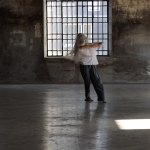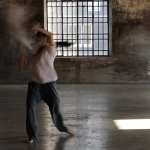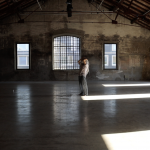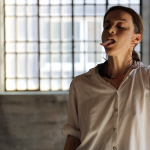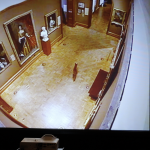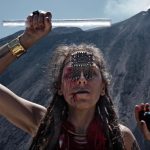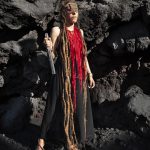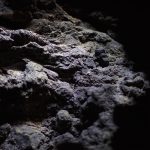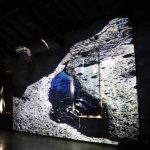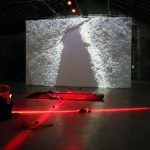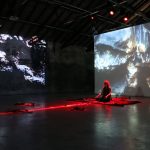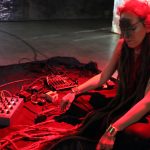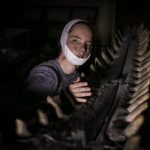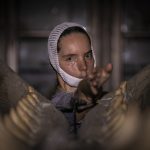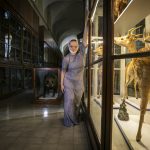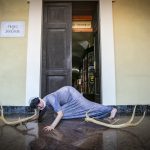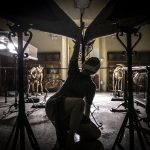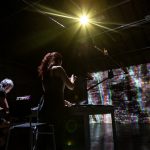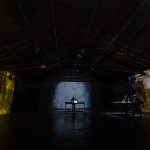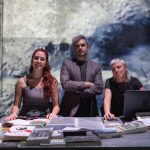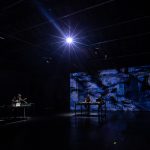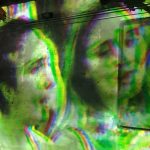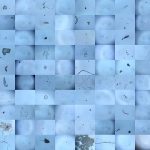
Relatives 22-24
Bestiary
Female Animal, 12 Actions
After the edition all women In the 2021, the international performing arts festival Natura Dèi Teatri active in 2022 path BESTIARY | Female Animal, 12 ACTIONS | RELATIVES for new naturalcultural performative models, hybridizing philosophy, mythology, sciences and arts. In the three-year period 2022_2024 twelve of the most interesting artists* and collectives on the national and international scene will be invited* to co-produce with the Lenz artists 12 paths that will investigate the themes of gender roles, anti-speciesism, ecofeminism, overcoming dualisms through projects divided into residencies, productions, laboratories, seminars, show presentation. The reference field of study will be the theoretical corpus of the American philosopher Donna Haraway in the direction of the advent of let's go, by creating RELATIVES based not on biological continuity but on the recognition of affinities and differences and the possibility of coexistence.
In a historical period in which the definition takes on significant importance and the signifier is fundamental to ensure the guaranteed existence of the meaning, visibility and representation, Lenz aims to ensure representation spaces for women active in the cultural field, aimed at sharing the words and practices necessary for one's project of generating new worlds. Lenz will increasingly become a physical and intellectual space aimed at giving shape to apparent utopias described by terms such as sustainability, equity, accessibility, feminism, transfemminismo, interculture vs cultural appropriation, gender medicine, intersectionality, activism, regeneration; apparent utopias characterized by a goodness of action that is making reality of the imaginary concrete in places (physical, social, virtual) of community.
Bestiary 9
Handle with care
Lorenza Guerrini [playwriting]
Residence + Laboratory practices + Show 2>12 April Public sharing 11-12 April
Bestiary 10
Esaltazioni III _ Tauride
Valentina Barbarini [body]
Laboratory practices 24 maggio > 27 June Public sharing 26-27 June
Bestiary 11
Human Inhuman Posthuman
Monica Barone [posthuman]
Residence June Public sharing 20-21 June
Bestiary 12
Hybridize
Giulia Odetto [ibridazione]
Residence + Laboratory practices 7>16 November Public sharing 15-16 November
Bestiary 5
Day of wrath
Gloria Dorliguzzo [resistence]
Residence + Laboratory practices 10>26 April Public sharing 25-26 April
Bestiary 6
Exaltations II _ Aulis
Valentina Barbarini [body]
Residence maggio Laboratory practices 8>31 maggio Public sharing 30-31 maggio
Bestiary 7
Dancing Babies
Lucia Perego [neonatality]
Residence June + September Laboratory practices 6>27 June + 5>19 September Public sharing 19-20 September
Bestiary 8
Fòro Fòro
Muna Mussie [decoloniality]
Residence October SeminariO 13 ottobre con Sofia Bacchini e Davide Persico Public sharing 12-13 October
Day of wrath
Born from a reflection on coercion and violent and destructive forms of power, the musical performative work performatively reinterprets the work of the Russian composer Galina Ustvolskaya (1919-2006), nicknamed Woman with Hammer, whose scores are supported by repetitive frameworks, Peter, interrogative and drastically essential.
In the human being the body is his instrument, the object is the weapon with which to create his ideal. On the one hand, a ferocity directed towards an end in which collective participation emerges, on the other, violence, self-generated by itself, uncontrollable: Dionysian creativity. The body constantly responds to this destructive impulse by trying to overcome the fear of death. In close relationship with power, the sound of these events can only be disarming, tragic, absolute.
Galina Ustvolskaya, the living embodiment of the Resistance, knew this well. Allieva di Shostakovich, he soon distances himself from the master, guilty in his eyes of having accepted compromises with the Stalinist dictatorship, not sharing its dual and "not pure" attitude. On the contrary, the composer proves to have a compact morality, following a compositional research that tends towards a strong reduction of the material towards an ideal of drastic essentiality. His music is continually questioning, absolute and extreme; Galina chooses repetitive and pounding frameworks for her scores.
The sound is interrupted, obsessive and petrous, sometimes excruciating in the dissonant sound explosion.
The performance – a mysterious ritual of Dionysian creativity and intimate liberation from homogenizing powers – involves a group of women from the Parma area in a performative concert of hammers on anvils and wood.
Wednesday 25 April | ore 17:00 + ore 19:30
Thursday 26 April | ore 18:00 + ore 19:30
- Conduction and composition Gloria Dorliguzzo
- Musical coach Maestro Gianluca Feccia
- Music consultancy Maestro Riccardo Munari
- Freely inspired by the music of Galina Ustvolskaya
- Performer Monica Barone, Lara Bonvini, Tiziana Chapel, Zoe Frazzi, Francesca Ghisotti, Nicolle Montanari, Teresa Morisano, Agatha Pelosi, Carlotta Spaggiari
- Production Lenz Foundation + C&C company
- In collaboration with l’Historical Institute of the Resistance and the Contemporary Age
Iphigenia in Aulis
Laboratory aimed at people belonging to the Pathological Addictions Service of the Parma Local Health Authority
Valentina Barbarini, associated artist protagonist of the sixth Parentela 2023 of the three-year Lenz NDT project.02 Bestiary_Female Animal, In the 2023 led the Social Theater Practices workshop – in co-teaching with the performer Monica Barone and aimed at people belonging to the Pathological Addictions Service of the Parma Local Health Authority. The lab, centered on the myth of IPHIGENIA IN AULIDE, led to a public performative outcome at Lenz Teatro il 30 and the 31 maggio.
Synopsis of the laboratory
Continuing the study of the material of Iphigenia in Aulis means taking up an investigation into the multiple possibilities that hide along an apparently marked road. Investigating the passive acceptance of a higher order from different perspectives, of a male power taken for granted, the rebellion, or the choice of an individual and hybrid path that hides behind the most immediate appearances of the narrative. A hybrid path in which each is placed, in full legitimacy, at a different point. In this sense, laboratory practice is also a path, un itinerario verso l’autorizzarsi ad avere una voce.”
- Residence, management and composition Valentina Barbarini
- Co-appreciation Monica Barone
- Musica Andrew Azzali
Dancing Babies
Expectant mothers and their newborns are invited to experience the possibility of an unprecedented encounter, intimate and profound, led by an expert in the theory ofembodiment applied to prenatal.
PHASE #1 __ JUNE __ ORE 10:30_12:00
Tuesday 6 + Tuesday 13 + Tuesday 20 + Tuesday 27
In the first phase of the laboratory, which will be held in June, expecting women will be able to experience a 'time' of listening, a suspended and protected place where you can view, imagine, play, dialogue with your child through movement-breath-relationship, poetic and vital act of rare depth.
Work represents an opportunity for the mother to become aware of the child's growth within her body, seeing him transform, feeling and experiencing the great adaptations of its forms in relation to the growth of the child.
PHASE #2 __ SEPTEMBER __ ORE 10:30_12:00
Tuesday 5 + Friday 8 + Tuesday 12 + Friday 15 + Tuesday 19
In the second phase of the laboratory, which will be held in September, it will be experienced, within the mother-newborn relationship, the freedom of an encounter that leaves room for the child's movement, at play with the mother's body and the environment.
The music, the lights, the materials present will be both stimuli and cognitive support, 'breathing lungs' to create an embodiment between mothers, son and place.
Subject to the consent of the participants, the lab (both in the phase 1, both in the phase 2) it will be documented through video recordings and subsequently transcribed into visual sequences presented in public form.
The free workshop takes place at Lenz Teatro, via Pasubio 3/e. To participate you need to write an email to info@lenzfondazione.it, o call the number 0521 270141 or write on Whatsapp to 335 6096220.
Lucia Nicolussi Perego
Lucia Nicolussi Perego is a choreographer, dancer, teacher, educational director and founder in 1983 of the Compagnia Era Acquario dance school. Born in Vicenza, he graduated in Psychology in Padua, lives and works in Parma where she collaborated as an interpreter and choreographer with Teatro Due, Lenz Foundation, Teatro delle Briciole-Teatro al Parco, Nature The Theaters.
His work studies the body as a bearer of dramaturgy where I breathe, gesture and voice merge into one, dialectical crossroads.
He obtained the IDME certification (Infant Developmental Movement Education) rilasciata da The School for Body-Mind Centering®, With the’ objective of helping newborns and children in their natural process of psycho-corporeal growth.
Relationship 8
Fòro Fòro – versione solo
Muna Mussie [decoloniality]
Residence 9>14 October
Performance 12>13 October
SeminariO 13 October
Muna Mussie è l’ottava parentela di BESTIARIO | Female Animal, il progetto di Lenz che invita dodici artiste e collettivi associati a co-produrre residenze, progetti nazionali ed internazionali, laboratori e seminari transdisciplinari sui temi dei ruoli di genere, anti-speciesism, ecofeminism, overcoming dualisms.
Muna Mussie (Eritrea 1978) inizia il suo percorso artistico nel 1998 formandosi e lavorando come attrice e performer con Teatrino Clandestino e Teatro Valdoca. Dal 2001 al 2005 è parte fondante del collettivo di ricerca Open. Tra le sue produzioni recenti, l’installazione e performance Milite Ignoto (2015), le performance Oasi (2018), Curva (2019), Curva Cieca (2021) e PF DJ (2021), la performance Bientôt l’été (2021) sul nomadismo mentale e erranza, e PERSONA (2022), incontro ad personam mediato dalla pratica del cucito. I recenti progetti Oblio (2021) e Oblio/Pianto del Muro (2022) introducono una ricerca sull’arte pubblica.
FÒRO FÒRO – versione solo è parte del progetto MORFOLOGIE DEL PAESAGGIO _ REIDRATAZIONI DEL PRESENTE URBANO, con cui Lenz rigenera il patrimonio museale dell’Università di Parma attraverso il linguaggio visuale e artistico contemporaneo.
La residenza a Lenz dell’artista eritrea Muna Mussie prevede un periodo di studio alla Sala Bottego del Museo di Storia Naturale dell’Università di Parma, da cui nascerà una versione solo della performance FÒRO FÓRO, che mette in dialogo persone cieche e vedenti attraverso il Braille e il Ricamo, linguaggi differenti accomunati dall’imprimere una superficie, rivelando un’immagine tattile.
Fòro fóro è l’accadimento pubblico che segue le pratiche agite in Verso l’immagine, laboratorio che interroga l’immagine a partire dal dialogo tra persone cieche e vedenti attraverso due linguaggi differenti: il Braille, un metodo di scrittura e lettura formato da punti in rilievo, e il Ricamo. Entrambi questi linguaggi imprimono o traforano una superficie, riportando alla luce un segno, A form, un’immagine tra il visibile, invisibile, tattile.
Per Fòro fóro Muna Mussie trae ispirazione dal gioco della matassa analizzato da Donna Haraway, che riconosce nelle “figure di filo” un’analogia con i processi di pensiero e di creazione, pratiche pedagogiche e performance cosmologiche. Creare delle figure di filo significa passare e ricevere, scegliere dei fili o lasciarli perdere, fare e disfare, tracciare e seguire una trama nel buio, per iscrivere altre storie.
Per Lenz, nell’ambito del progetto residenziale 2022_2024 Relatives, l’artista e il suo cerchio di alleat_ si esporrà nel fare e dire parole, alludendo all’interscambio tra fòro, luogo anticamente legato al ritrovo della comunità, del commercio, della politica e della giustizia, e a fóro che rimanda a un buco da cui entrare e uscire.
Bestiary 1
The language of the night
Annamaria Ajmone [anti-speciesism]
Residence 9>15 + 16>22 maggio
Laboratory practices 12>14 maggio
Public sharing 18>21 maggio
Bestiary 2
Ritual II Embrace the darkness
Stefania ?Alos Pedretti [transfemminismo]
Residence 27>30 June+ 1>17 July
Laboratory practices 28>30 June
Public sharing 12>15 July
Bestiary 3
Allegedly, inhuman, posthuman
Monica Barone [postmanesimo]
Residence 2>15 July + 12>27 September
Laboratory practices 3 maggio > 22 June
Public sharing 28>29 September
Bestiary 4
The Critters Symposium
Jan Voxel Digital Art [digitalisation]
Residence 11>13 + 19>25 October
Concerto 14>15 October
Laboratory practices 19>28 October
Public sharing 26>28 October
The Forest and the meetings
A search starting from Night is my favorite day
Annamaria Ajmone continues with Stella Succi, independent researcher, the animal tracking project following the path of creation Night is my favorite day. Imagined and created with Natália Trejbalová (visual artist), Stella Succi (researcher), Giulia Pastore (light designer), Jules Goldsmith (costume designer), Flora Yin-Wong (sound artist), the work was born from the desire to explore the relationship with others. Another non-human, animal and plant, which one looks at not as a landscape to be conquered and photographed, from a tourist perspective, but as a hidden ecosystem, to co-live.
To prepare for the show, the group organized a residency in the territories of Val d'Illiez and Jura, in Switzerland: to relate to the environment, experimenting with the continuous and nocturnal practice of tracking. Described by Baptiste Morizot within the essay On the animal track, published by at night, tracing is an exercise to «activate within oneself the powers of a different body», cross the territory, borrowing the body and perspective of another in a non-appropriative sense, that configures the world differently.
His choreographic work forces the viewer to move and change perspective, reacting to physical stimuli launched by her. He proposes again, in an 'anthropological' key, the philosophical sense of his nocturnal explorations carried out following animal tracks in the Swiss woods, under the guidance of forestry engineers. Night sightings: what are the strategies that the fox implements? And the wolf? And we non-human animals, we can learn to reorient ourselves in a natural environment, observing animal intelligence?
These questions will be the theoretical corpus around which the sharing evenings in Lenz will develop. The public will be accompanied into a nocturnal forest, symbolic and techno-natural, in which to experiment with a new pedagogy of the gaze, which asks to decentralize ourselves from the anthropocentric view, to stay inside the disorientation, to the sense of finitude, In the end, to feel part of 'nature' in all respects, moving away – therefore – from the idea of landscape as the backdrop for human action.
In the evenings of Thursday 19, Friday 20 e Saturday 21 maggio we will open the Lenz theater to the public, with three meetings that will try to follow some subtle traces of Night is my favorite day, (dis)orienting yourself freely and partially between the readings, Annamaria Ajmone and Stella Succi will share the visual and sound documents that create an interactive space to be explored on the artist's website [go to the site].
Plan
Thursday 19/05 | ore 21
Performing lecture, that is, the possibility for those who participate to delve deeper into the texts in direct contact with the artist and the researcher, the sounds and visions that inspired the stage translation.
Friday 20/05 | ore 21
The forest and meetings, the story of the animal tracking practice in dialogue with Annamaria Ajmone, Stella Succi e Davide Persico, paleobiologist from the University of Parma and Director of the Natural History Museum of the University of Parma.
Saturday 21/05 | ore 18
Performance, Annamaria Ajmone concludes the residency journey with a stage translation inspired by her show Night is my favorite day.
Ritual II Embrace the darkness
The search for ?ALOS weaves various threads together, practices that often seem very distant from each other.
In his research path, live music is the central element crossed and reread in each performance from a different performative key appropriate to the object of investigation.
His work transcends the boundaries between the arts performative, integrating experimental music, performance, improvisation, figurative art, installation and video/art, and has the aim of actively involving the public in a show capable of providing a strong sensorial experience.
Her performances and artistic works have always had as their fulcrum the struggle for the clearance and acceptance of the different in a queer transfeminist key.
His current research is aimed at transposing the dramaturgy of the RITE in a contemporary key, an exploration of the relationship between sound and nature, the five senses which are opportunities for study, ignition points of projects that cross the vibrations of sound with those of the body, stage acting with vocal performance.
The body is the expressive instrument, from hair to skin, from voice to breath.
Live is a Ritual, a collective experience, a sonic and emotional journey.
?Alos feels the time has come to go beyond itself, taking a step back. Disrupting the linearity of design thinking again, looking for the path that leads to understanding abstract thought, with ever greater determination.
Not a path of personal growth, nor one healing practice collective, nor the accurate explanation of a profound intuition, but the staging of abstract thought. How to destroy the verb? Throwing it into the mouth of a volcano, drowning the words in the shadow and rot of vegetal proliferation, throwing them into the spirals of fire hidden inside clouds of black smoke.
Choose places for the symbolic value of their light, thus starting to work on a ritual that was created at the same time and in proximity to a volcanic eruption.
Why, reconnecting to the semiotics of dreams, il volcano it has a symbolism that incorporates the meanings of the four fundamental natural elements: fire (il magma, the lava), the air (the profusion of gas, smoke and ashes that project upwards, in the sky), the water (the water vapor it expels, as well as the flow of lava along the sides) and the earth: the volcano is the mountain that connects the depths of the Earth (unconscious) towards the sky (conscious thought).
This Ritual II aims to “explore opposites, the two ends of the Whole. Why "everything – the light, the dark, the beauty, the pain – is perfect just as it is.“
Allegedly, inhuman, posthuman
It's the science fiction novel “But androids dream of electric sheep?” at Philip K. Dick to generate comparative reflection on the forms of knowledge underlying “Allegedly, inhuman, posthuman” first performance conceived and interpreted entirely by Monica Barone.
The work starts from a critical position on epistemology, and in particular to epistemology, with its implicit socially recognized primacy to scientific knowledge, to suggest the awareness of an ancestral and profound intelligence as an evolutionary process, preceding the nature-culture binary.
Monica Barone crosses the Rector's Corridor blindfolded, in a dynamic supported by expectations full of tensions and in a dialectical relationship with the identity of the space, to whose strong connotation she responds by subtraction and contrast, guided by the sound design of Andrea Azzali, electronic mix of animal and bone sounds.
As in Japanese butō dance, Monica Barone's body becomes an instrument to redefine the landscape: voluntarily denied sight, the performer tests proprioception, the sense of internal perception of the body in space and time, going through the entire celebratory passage of Western science to get to undress with the help of a pair of large deer antlers.
A climactic gesture, which introduces the entrance to the Systematics and Skeleton Rooms, marking a choreographic change, scenographic and conceptual: the more rounded and fluid movements, placed on different levels, animal postures and behaviors echo, the light progressively decreases until it illuminates only the skeletons of ancient creatures, didactically recomposed by the guiding thought in contrast with the taxonomic thrust, indication of possessive and controlling will, and moved by the intention of evoking the dignity of intuitive forms of knowledge.
The Critters Symposium
Bestiary of words and images for the fossil age
The project is intended as a further ramification/development of The Critters Room. The objective is to build a path of meeting/co-presence/germination between the corpus of images of the invisible inhabitants of the air – the ghosts of the anthropocene by The Critters Room – and the words/voices/gestures of a group of performers, artiste, diligently. A "choir" that we propose to build in the coming months, in a sorority call, imagining the composition together with Lenz, meeting people (in the presence or – if not possible – in remoto), offering and nourishing ourselves with their offering, choosing a textual corpus that belongs to the DNA of The Critters Room and letting all possible hybridizations flourish.
The corpus of images will be processed by Jan Voxel and presented in the form of a video, a responsive flow capable of establishing a real-time dynamic with the choir. We imagine this performative event of images and voices as an open laboratory, first provisional summary of the journey undertaken.
A list (indicative) of reference authors from which to draw the vocal score: Donna Haraway, Matteo Meschiari, Ursula K. Guin, Andri Magnason, Anna Tsing, Timothy Morton, Antonella Anedda, and other.
The Critters Room embodies a loving practice of physical and digital archiving of atmospheric particulates (Critters, quoting Donna Haraway). The protagonists of the project are: the archive and the community.
The slide archive: a corpus of more 400 microscope slides that document the air we breathe over time. By exposing to the air for 12/24 hours the slides, it was possible to collect "samples", where you can view the Critters, impalpable particles such as pollen, plant fragments, silicates, metallic particles and atmospheric particulates, the famous PM10 and PM2.5, unburned hydrocarbon residue.
Questi sono i veri “Ghosts and Monsters of the Anthropocene”, then-living creatures that the present fossil era brings back into the air, to attack (haunt) our present.
To share spaces and times with the now-living, forcing us to “make alliances” (making kin) to stay in contact – as Donna Haraway says – with a damaged planet.
The performative action began on March 8 2020 (first day of lockdown following the Covid-19 pandemic) and it is still ongoing.
The photographic archive: each slide was photographed with an optical bench designed specifically for the smartphone. The two archives (material and photographic) they are in progress and are enriched thanks to the residencies (and to duly "trained" citizens who are called to collect air samples from their terraces) and to the community that Jan Voxel is building around the project.
The data archive: file with pm10 and pm2.5 atmospheric particulate detection data. The files can be freely downloaded from the sensor.community website, which collects data from all the home-built air control units installed in the world. These control units are to be understood as citizen science devices, grassroots citizen participation and activism.
The community and its sound archive: environmental recordings and interviews collected during the residencies, with the aim of keeping that multiplicity of human subjects in archive (social) who deal in various capacities with basic democracy, of environmental activism and citizen science, united by practices of responsibility and close in an alliance "against the inevitable".






